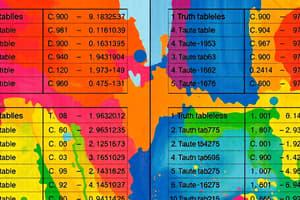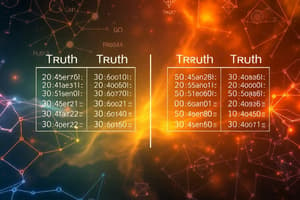Podcast
Questions and Answers
What is the purpose of a truth table?
What is the purpose of a truth table?
A truth table shows how the truth or falsity of a compound statement depends on the truth or falsity of the simple statements from which it's constructed.
What are the five logical connectives?
What are the five logical connectives?
The five logical connectives are negation (¬), union (∧), disjunction (∨), implication (→), and biconditional (↔).
What is the truth table for the implication connective?
What is the truth table for the implication connective?
P Q P → Q 1 1 1 1 0 0 0 1
What is the truth table for the negation connective?
What is the truth table for the negation connective?
Which connective is represented by the symbol '∧' in the truth table?
Which connective is represented by the symbol '∧' in the truth table?
What is the truth table for the biconditional connective?
What is the truth table for the biconditional connective?
What is the truth value of 'P ∧ Q' when P is true and Q is false?
What is the truth value of 'P ∧ Q' when P is true and Q is false?
Which connective is represented by the symbol '∨' in the truth table?
Which connective is represented by the symbol '∨' in the truth table?
What is the truth value of 'P ∨ Q' when P is false and Q is false?
What is the truth value of 'P ∨ Q' when P is false and Q is false?
Which connective is represented by the symbol '→' in the truth table?
Which connective is represented by the symbol '→' in the truth table?
Flashcards are hidden until you start studying
Study Notes
Purpose of a Truth Table
- A truth table is used to calculate the validity of logical arguments and to test the consistency of a set of statements.
Logical Connectives
- There are five basic logical connectives: implication (→), negation (¬), conjunction (∧), disjunction (∨), and biconditional ().
Implication Connective
- The implication connective is represented by the symbol '→' in a truth table.
- The truth table for the implication connective shows that if P is true and Q is false, then P → Q is false.
Negation Connective
- The negation connective is represented by the symbol '¬' in a truth table.
- The truth table for the negation connective shows that ¬P is true when P is false, and ¬P is false when P is true.
Conjunction Connective
- The conjunction connective is represented by the symbol '∧' in a truth table.
- The truth table for the conjunction connective shows that P ∧ Q is true when both P and Q are true, and false otherwise.
- The truth value of 'P ∧ Q' is false when P is true and Q is false.
Disjunction Connective
- The disjunction connective is represented by the symbol '∨' in a truth table.
- The truth table for the disjunction connective shows that P ∨ Q is false when both P and Q are false, and true otherwise.
- The truth value of 'P ∨ Q' is false when P is false and Q is false.
Biconditional Connective
- The biconditional connective is represented by the symbol '' in a truth table.
- The truth table for the biconditional connective shows that P Q is true when P and Q have the same truth value, and false otherwise.
Studying That Suits You
Use AI to generate personalized quizzes and flashcards to suit your learning preferences.




